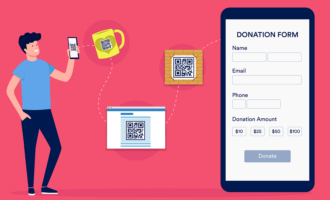Whether your online fundraising efforts involve a web page, social media, or crowdfunding, you need to balance attracting new donors with retaining credibility. Attention spans are notoriously short for web audiences. Use these five steps to ensure your organization maintains its mission while embracing the conventions of the web:
1. Get to the point quickly and cleanly
The front page of your website is like the stall at a fair. People might decide in a single glance if they do or don’t want to donate. Roughly half of people visiting a website mention design when judging the organization’s credibility.
Cluttered messaging and hard-to-read formats will confuse visitors and turn them away. Therefore, simple is best when it comes to web design.
What does simple design look like? Avoid filling up pages with endless sentences. People prefer short, direct messages. Brief statements, like “Yes we can” and “Just do it,” work well in advertising and politics because they’re easy to remember.
High-quality photos are also a must, but make sure they have a direct relation to your cause. Authenticity is more important in nonprofit branding than for commercial web pages. To get these shots, hire a professional photographer to ride along on your next campaign.
Reduce the amount that your users have to scroll. More than half of visitors leave within 15 seconds. Think about each page’s function. Analyze how it directs your readers and contributes to the overall site.
When you aim for simplicity, you put the focus on what your nonprofit actually does.
2. Make donating easy
Donors are confronted with overwhelming amounts of digital content. If they have to click through more than a couple of pages, they give up. Therefore, calls to action, like a “donate” button or a short pitch asking for funds, should be clear and easy to navigate.
To facilitate donating, consider including a PayPal button in a top corner of the donate page. Having a prominent button for donations will allow donors to give as soon as they arrive on your landing page. Take care that the option to donate is available and visible but never in the way.
Embrace mobile and social media. Your digital presence is sharable, unlike a phone call or a fundraising event. Brainstorm the best ways to make your content go viral. Identify and implement tools that allow you to collect and track data on how these online channels are performing.
Small design tweaks can have surprisingly big effects. For example, try using a colored background rather than an asterisk for required fields. This small detail makes filling out forms faster and easier for your respondents.
Provide suggested donation amounts. Psychologically, people look to others, like neighbors and friends, for approval. Suggested amounts give donors the support they want when deciding how much to give. Moreover, studies show that suggested amounts increase average donations by 12 percent. Don’t give too many options, or you risk confusing donors. Providing one to eight options, along with a custom amount field, is about right.
3. Make donors feel appreciated
Showing appreciation may sound overly simple, but thanking your donors can motivate them to tell others about your organization. Thank them through phone calls, social media, email, or any other medium you use to communicate with your audience.
In your thank-you message, make sure to illustrate the impact their donation has had. Try using a high-quality picture of someone the nonprofit has helped. Donors can be motivated to renew their donations if they know that the money they spent has had a positive effect on someone’s life.
If appropriate, create a thank-you section on your website where you list your most long-standing and generous supporters.
4. Test your forms
Go through the process as if you’re the donor. Complete the form on multiple devices, operating systems, and browsers.
Once you’ve made sure the form for your nonprofit organization works smoothly everywhere, check on the backend results. Follow your donations from the website to your database and, ultimately, to your bank account. Make sure the donations also show up in any web development tools that you use for analysis or reporting. If an automatic thank-you email is sent to the submitter, verify that it’s sending email to the correct address. If the email field is left blank, make sure the process doesn’t send an email.
Beyond the functional aspects, fix any broken or confusing workflows and instructions. Invite staff, friends, or donors to test out your form and provide feedback. Follow up on their suggestions.
5. Get better engagement through education
In today’s world of media saturation, you need to do more than just tell your nonprofit’s story well and often. You also need to engage with your audience. Engagement could involve hitting the “Like” button, replying to comments, or curating content from your fans. The more deeply involved you are, the higher the rewards will be.
One of the best ways to engage is to educate. People expect organizations to be accountable. Prove that you are by educating them on the cause. Show your donors the benefits of donating and how their funds will make an impact. You can send emails or letters or start a petition. Ask them to chip in by sharing your message on social media.
Then, share the results by giving them updates from donation recipients. Encourage continued interaction by posting a profile of one of your biggest donors. Provide resources on how to claim tax deductions. Have as much information as possible readily available.
With this information, you can use all the resources available on the internet to improve your online fundraising.























Send Comment:
1 Comments:
More than a year ago
Good and perfect.